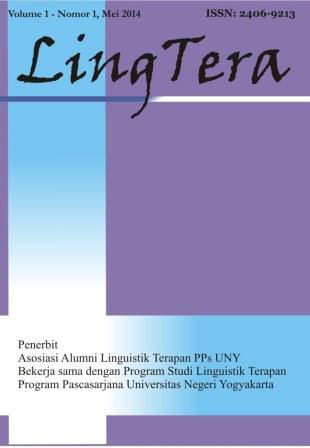A segmental analysis of the Japanese negation verb variation: A phonological perspective
DOI:
https://doi.org/10.21831/lt.v9i2.54478Keywords:
segmental analysis, Japanese negation verb, phonologyAbstract
References
Burquest, D. A. (2001). Phonological analysis: A functional approach (2nd Ed). SIL International.
Crystal, D. (2008). A Dictionary of Linguistics and Phonetics (6th ed.). Blackwell Publishing.
Dixon, R. M. W. (2012). Basic linguistic theory: Volume 3 further grammatical topics. Oxford University Press.
Fromkin, V. A. (2000). Linguistics: An introduction to linguistic theory (1st ed.). Blackwell Publishing.
Hamasaki, H., & Nakayama, N. (2016). Orange [Television series]. Telecom Animation Film.
Inozuka, H., & Inozuka, E. (2007). Nihongo onsei no shikumi. Kenkyusha.
Irwin, M., & Zisk, M. (2019). Japanese linguistics. Asakura Publishing.
Ishiguro, K. (2017). Nihongo wa「kuukiã€ga kimeru: Shakai gengogaku nyuumon (3rd Ed). Kobunsha.
Ito, N. (2013). The polite negative predicate verb forms in Japanese, "masen" "naidesu" : Approach through politeness theory. Suzuka International University Journal Campana, 19, 65–80.
Katou, S. (2008). Shiriizu Nihongo no Shikumi o Saguru 4: Nihongogaku no Shikumi (4th Ed). Kenkyusha.
Kawaguchi, R. (2010). Masen katachi kara nai desu katachi e no shifuto ni kakawaru youin ni tsuite: Doushi hitei teineikei no gengo henka to iu shiten kara. 日本語教育, 144, 121–132. https://doi.org/10.20721/nihongokyoiku.144.0_121
Keraf, G. (2006). Diksi dan gaya bahasa. Gramedia Pustaka Utama.
Kishimoto, H. (2013). Verbal complex formation and negation in Japanese. Lingua, 135, 132–154. https://doi.org/10.1016/j.lingua.2012.11.007
Kishimoto, H. (2018a). Negation. In Y. Hasegawa (Ed.), The Cambridge handbook of Japanese linguistics (1st Ed, pp. 300–331). Cambridge University Press.
Kishimoto, H. (2018b). On the grammaticalization of Japanese verbal negative marker title. Journal of Japanese Linguistics, 34(1), 65–101. https://doi.org/10.1515/jjl-2018-0005
Knight, R. A. (2012). Phonetics: A coursebook. Cambridge University Press.
Koizumi, T. (2014). Nihongo kyoushi no tame no gengogaku nyuumon. Taishuukan Shoten.
Kubozono, H. (2015). Diphthongs and vowel coalescence. In Handbook of Japanese phonetics and phonology (pp. 215–246). De Gruyter Mouton. https://doi.org/10.1515/9781614511984.215
Matsushita, K. (2020). Onseigaku oninrion kara miru nihongo no hatsuon. Kyooritsu Komyunikeeshonzu.
Matsuyoshi, S. (2014). Hitei no shoten jouhou anoteeshon. 自然言語処ç†, 21(2), 249–270. https://doi.org/10.5715/jnlp.21.249
Muhammad. (2011). Paradigma kualitatif penelitian bahasa (M. Sukri (ed.); 1st ed.). Liebe Book Press.
Nakata, H. (2022). Mie ken iga hougen ni okeru doushi hiteiji no barieeshon: Sansedai no danwa shiryou ni motodzuite. 阪大社会言語å¦ç ”究ノート, 18, 1–25. https://doi.org/10.18910/86403
Nakazaki, T., & Shirota, S. (2020). Nihongo ni okeru doushi keiyoushi no hitei no katachi ni tsuite: Nihonho kyoushi no tame no nihongo bunpou o motomete. Shuujitsurongyou, 49, 53–71. https://doi.org/10.24771/00000490
Nitta, Y. (2010). Gendai nihongo bunpoo 1 (1st Ed). Kuroshio.
Odden, D. (2013). Introducing phonology (2nd Ed). Cambridge University Press.
Roca, I., & Johnson, W. (1999). A Course in phonology (1st Ed). Blackwell Publishing.
Sadler, M. (2020). Japanese negative suffix nai in conversation: Its formulaicity and intersubjectivity. Discourse Studies, 22(4), 460–482. https://doi.org/10.1177/1461445620914671
Schane, S. A. (1973). Generative phonology. Prentice-Hall Inc.
Shibatani, M. (1990). The languages of Japan. Cambridge University Press.
Siswanto, Suyoto, & Mukhlis. (2019). Pengantar fonologi (3rd ed.). Cakrawala Media.
Spencer, A. (2008). Negation in Japanese: A case of morphosyntactic mismatch. Lingua, 118(7), 997–1017. https://doi.org/10.1016/j.lingua.2007.04.004
Trask, R. L. (2006). A Dictionary of phonetics and phonology. Routledge.
Tsujimura, N. (2014). An introduction to Japanese linguistics (3rd Ed). Wiley-Blackwell.
Yamada, T., Shibata, T., Sakai, K., Kuramochi, Y., Yamada, A., Uwano, S., Ijima, M., & Sasahara, H. (2017). Shinmeikai kokugo jiten (7th ed.). Sanseido.
Yamaguchi, Y. (2021). Usage of "kunai?" and "kute" that spreads mainly among young people. å¦æ ¡æ•™è‚²ã‚»ãƒ³ã‚¿ãƒ¼ç´€è¦, 6, 122–129.
Yuzawa, T., & Matsusaki, H. (2005). Onsei Onintan Hoohoo: Nihongo e no Izanai. Asakusa Shoten.
Zaim, M. (2014). Metode penelitian bahasa: Pendekatan struktural. FBS UNP Press.
Downloads
Published
How to Cite
Issue
Section
Citation Check
License
LingTera allows readers to read, download, copy, distribute, print, search, or link to its articles' full texts and allows readers to use them for any other lawful purpose. The journal allows the author(s) to hold the copyright without restrictions. Finally, the journal allows the author(s) to retain publishing rights without restrictions.
- Authors are allowed to archive their submitted articles in an open-access repository.
- Authors are allowed to archive the final published article in an open-access repository with an acknowledgment of its initial publication in this journal.

Psychology, Evaluation, and Technology in Educational Research is licensed under a Creative Commons Attribution-ShareAlike 4.0 International License.
Based on a work at https://petier.org/index.php/PETIER.









